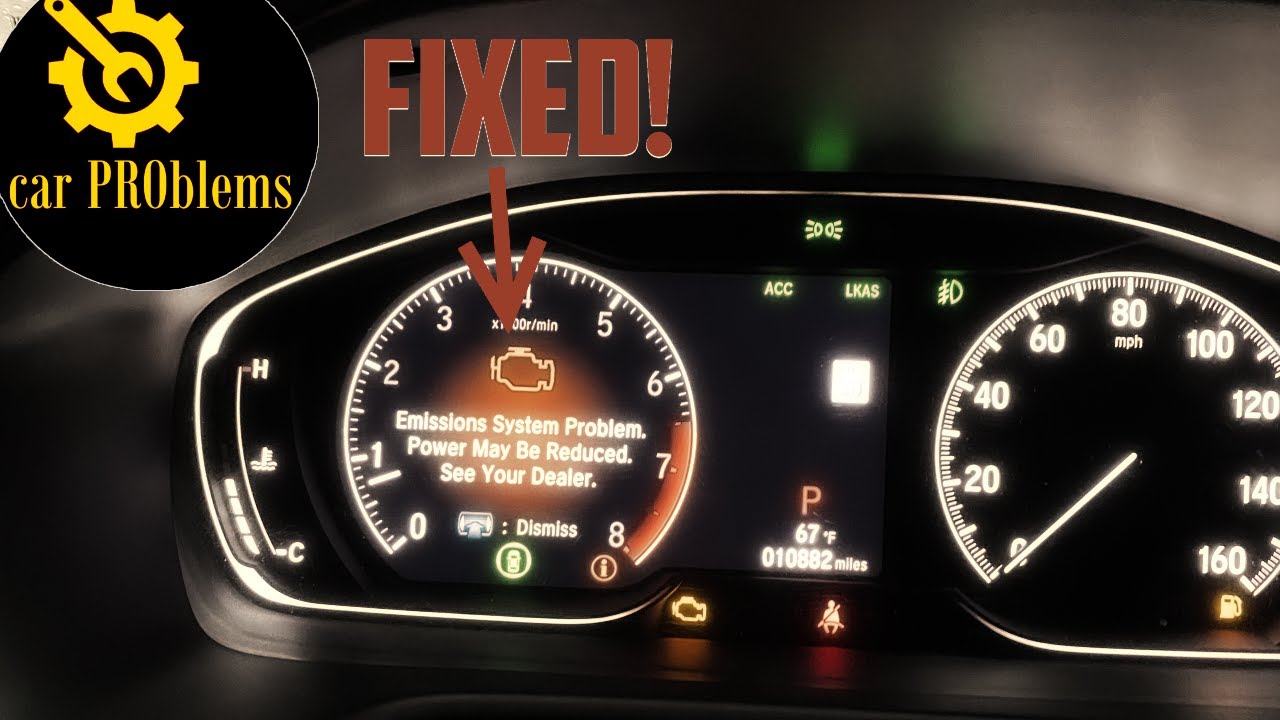To reset the check emission system on a Honda Civic, follow these steps. First, locate the negative terminal on the car battery and disconnect the cable.
Then, wait for about 10-15 minutes before reconnecting the cable. The check emission system in a Honda Civic is an important component that monitors the vehicle’s emissions and ensures they meet the required standards. However, sometimes the system may encounter issues and display warning messages on the dashboard, indicating the need for a reset.
By following a few simple steps, you can reset the check emission system, allowing your Honda Civic to function optimally. We will outline the exact steps to reset the check emission system on your Honda Civic, ensuring a smooth and hassle-free experience. So, let’s get started!
Common Causes
A Check Emission System warning on your Honda Civic can be an alarming issue, but it is often caused by simple issues that can be resolved easily. Here are some common causes:
| Causes |
|---|
| Loose or Faulty Gas Cap |
| Oxygen Sensor Malfunction |
| Catalytic Converter Issues |
| Fuel Injector Problems |
One of the most common causes for the Check Emission System warning is a loose or faulty gas cap, which can cause the fuel vapors to leak from the gas tank. Similarly, an malfunctioning oxygen sensor that is not detecting the correct air-fuel mixture can trigger the warning. Additionally, issues with the catalytic converter, such as clogging or damage, can impact the emission system’s performance. Fuel injector problems, like blockages or malfunctions, can also result in the warning.
If you encounter the Check Emission System warning in your Honda Civic, it is important to address the issue promptly. By checking and ensuring the gas cap is secured, investigating the oxygen sensor, inspecting the catalytic converter, and examining the fuel injectors, you can potentially resolve the problem and reset the warning.
Importance Of Resetting The Check Emission System
Resetting the check emission system is of utmost importance for your Honda Civic. By doing so, you can prevent further damage to the engine, which can ultimately save you from costly repairs or replacements. Ensuring optimal fuel efficiency is another advantage of resetting the system. When the check emission system is not functioning properly, it can lead to fuel inefficiency, causing your vehicle to consume more fuel than necessary. By resetting the system, you can bring back optimal fuel efficiency. Additionally, a healthy driving experience can be maintained by resetting the check emission system. When the system is functioning properly, you can enjoy a smooth and hassle-free driving experience without any unexpected issues or malfunctions.
Step 1: Check For Loose Gas Cap
If you are facing the issue of a check emission system warning light in your Honda Civic, there are a few steps you can follow to reset it. The first step is to check for a loose gas cap. Inspect the gas cap carefully for any damage or looseness. If you find any issues, tighten the gas cap until it clicks, ensuring a secure seal. Afterward, wait for a few minutes and check if the warning light disappears. It is essential to ensure that the gas cap is tightly sealed as a loose cap can trigger the check emission system warning. By following these steps, you can reset the check emission system warning light in your Honda Civic.
Step 2: Address Oxygen Sensor Issues
In order to reset the check emission system on a Honda Civic, it is important to address any issues with the oxygen sensor. To locate the oxygen sensor, refer to the vehicle’s manual for guidance. Once located, visually inspect the sensor for any signs of damage or corrosion. If any issues are detected, it is recommended to replace the faulty oxygen sensor. Taking these measures will help ensure that the check emission system is reset and functioning properly.
Step 3: Resolve Catalytic Converter Problems
If you suspect that your Honda Civic’s catalytic converter may be causing issues with the emission system, it is important to determine if it needs to be replaced. In such cases, consulting a professional mechanic is recommended for proper diagnosis and assistance. They will be able to examine the converter and provide their expert opinion on whether it needs repair or replacement. It is crucial to follow their recommendations as they have the expertise to resolve catalytic converter problems effectively. Taking their advice into consideration will ensure that the check emission system issue in your Honda Civic is addressed correctly and efficiently.
Step 4: Troubleshoot Fuel Injector Problems
If you’re experiencing fuel injector issues in your Honda Civic, using a fuel system cleaner is one potential solution. The cleaner can help remove any built-up deposits and improve the functioning of the fuel injectors. Additionally, it is important to follow the vehicle’s maintenance schedule to ensure proper fuel injector functioning. Regular maintenance tasks such as fuel filter replacements and using quality fuel can help prevent potential issues. However, if you are facing severe fuel injector problems, it may be best to seek professional help. A qualified technician will have the expertise to diagnose and resolve complex fuel injector issues, ensuring the optimal performance of your Honda Civic’s emission system.
Regular Vehicle Maintenance
Maintaining regular vehicle maintenance is crucial for the smooth functioning of your Honda Civic. Learn how to reset the check emission system and keep your vehicle in top shape.
| Regular Vehicle Maintenance |
| Adhering to the manufacturer’s suggested maintenance schedule is crucial when it comes to keeping your Honda Civic’s check emission system in good condition. This includes performing routine tasks to ensure the vehicle’s optimal performance and reduce emissions. One of the most important maintenance tasks is changing the engine oil and filters regularly. Oil helps lubricate the engine components and filters ensure that the oil stays clean and free from contaminants. Additionally, inspecting and replacing air filters as needed is essential, as clogged filters can restrict airflow to the engine and affect the emission control system. By following these maintenance practices, you can keep your vehicle’s check emission system functioning properly and reduce the risk of any emission-related issues. Remember to always consult your vehicle’s owner manual for specific maintenance intervals and guidelines. |
Use Quality Fuel
Purchase fuel from reputable gas stations. It is important to ensure that you are getting fuel from trusted sources to avoid any issues with your Honda Civic’s emission system. Reputable gas stations generally have strict quality controls in place, which helps to minimize the risk of using low-quality or contaminated fuel. Be cautious when refueling at unknown or unverified gas stations to prevent any potential damage to your vehicle’s emission system.
Using low-quality or contaminated fuel can negatively impact your Honda Civic’s emission system. Poor fuel quality can lead to carbon buildup, clogged fuel injectors, and increased emissions. To prevent these issues, always check the quality of fuel before refueling and avoid using fuel that looks questionable or smells odd. If you suspect that you have used contaminated fuel, consider getting your fuel system checked and cleaned by a professional.
In addition to purchasing quality fuel, you can also consider using fuel additives for added protection. Fuel additives can help clean your fuel system, remove carbon deposits, and improve fuel efficiency. Be sure to choose additives that are compatible with your Honda Civic and follow the manufacturer’s instructions for proper usage. Regular use of fuel additives can help keep your check emission system in optimal condition.
Drive Responsibly
Driving responsibly is crucial to reducing vehicle emissions, especially when it comes to resetting the check emission system on your Honda Civic. By following recommended speed limits and avoiding aggressive driving, you can improve fuel efficiency and minimize harmful exhaust emissions. Additionally, minimizing idling time can further reduce emissions. Whenever possible, consider carpooling or using public transportation to reduce the number of vehicles on the road and decrease overall emissions. By adopting these practices, you can contribute to a cleaner environment and maintain the optimal performance of your Honda Civic’s emission system.

Credit: www.reddit.com
Conclusion
Resetting the check emission system on your Honda Civic is a necessary step in maintaining your vehicle’s performance and reducing emissions. By following the simple steps outlined in this guide, you can quickly and effectively reset the system yourself, saving both time and money.
Remember to always consult your vehicle’s manual for specific instructions and troubleshooting tips. Keep your Honda Civic running smoothly and being environmentally responsible by regularly resetting the check emission system.

